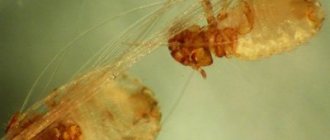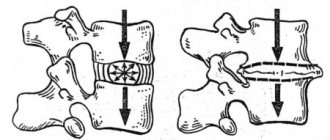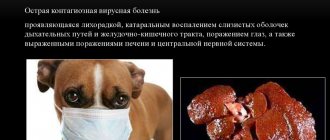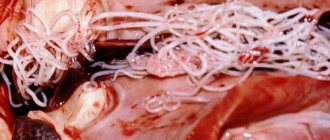Balanoposthitis in dogs - this term refers to the combination of an inflammatory process involving the head of the penis and its foreskin due to the intensive proliferation of pyogenic microflora (streptococci, staphylococci, candida fungi, Pseudomonas aeruginosa). Both an adult male and a young male can get sick. German shepherds and golden retrievers are most susceptible to balanoposthitis.
Owners of purebred dogs should keep in mind that ignoring the problem can lead to the inability to procreate. Inflammatory processes on the head of the penis occur in almost all male dogs, but usually everything goes away on its own, without visible consequences due to rapid self-healing.
What kind of disease is this
Balanoposthitis in dogs is a bacterial inflammatory process that occurs on the glans penis and prepuce. It can occur due to the fact that stagnation of sperm and urine occurs in the preputial sac. This disease is considered very common.
A photo of balanoposthitis in dogs is shown below.
As a result of inflammation, swelling of the organs occurs, and the dog experiences significant discomfort and pain. It should be noted that in males who have reached the age when they can give birth, the initial forms of balanoposthitis can often manifest themselves spontaneously. Mild forms of balanoposthitis in dogs do not pose a serious threat to the life and health of the animal and can even heal spontaneously. However, in cases where pathogenic microorganisms interfere with the inflammatory process, the disease can have serious consequences.
If such a disease is started, it can end in the loss of the sexual organ. In addition, in severe forms, the infection often spreads to the testes, and this already threatens the development of severe orchitis, which can later develop into peritonitis. There is a common belief among dog owners that balanoposthitis occurs only in old dogs, but this is a misconception. In the practice of veterinarians, there have been cases when this disease was diagnosed in puppies. Although this is rare, the consequences can be severe.
Forecast and prevention of the disease
If the breeder contacts you in a timely manner, the prognosis for balanoposthitis is favorable. If the pathological process is started, then the infection can pass through the urethra to the genitourinary organs, causing cystitis, urethritis, prostatitis, pyelonephritis, etc.
Prevention consists of early diagnosis of phimosis in a puppy, a pathology that makes it impossible to properly clean the penis. A minor operation will correct the anomaly.
For a male dog, after walks and heavy contamination of the abdomen and groin area, it is necessary to wash the belly, paws and rinse the preputial sac. If possible, eliminate all factors that provoke damage and contamination of the prepuce.
It is recommended to show the male dog to a veterinarian 2-4 times a year in order to promptly identify problems with the external genitalia. It is better to castrate dogs that are not breeders, so there will be no chance of contracting sexually transmitted infections that are possible during mating.
If you notice that your dog is showing excessive anxiety, paying too much attention to the groin area, swelling and redness have formed around the penis and there are all signs of an inflammatory reaction - do not hesitate! Call the RosVet VC by phone, 24 hours a day. Make an appointment with a veterinary urologist (general practitioner), show your dog to a specialist and be sure to carry out the prescribed treatment. Reception is available 24 hours a day.
What do you prefer to feed your pets?
Poll Options are limited because JavaScript is disabled in your browser.
- Porridge with various additives 46%, 7427 votes
Owners of male dogs often notice purulent discharge around the prepuce or on the abdomen, sometimes their pet is overly interested in its genitals, the dog often licks the prepuce. This is how a fairly common pathology manifests itself - balanoposthitis. In some cases, follicles (vesicles) are observed on the mucous membrane of the penis, mainly at the base - this is the follicular form of balanoposthitis.
Why does balanoposthitis occur?
Balanoposthitis is an inflammation of the glans penis (Balanitis) and prepuce (posthitis). As a result of stagnation of urine and sperm in the preputial sac, pathogenic microflora multiplies, which leads to inflammation of the mucous membrane. The etiology of the follicular form of balanoposthitis is not fully understood; one of the reasons may be an allergic reaction. Also one of the reasons for the follicular form is a decrease in local immunity. Therefore, in the treatment of balanoposthitis, it is advisable to prescribe immunomodulators, for example Roncoleukin.
Attention: Only a doctor can prescribe immunomodulators, having assessed the animal’s condition and the advisability of their use in a particular case.
What to do if you notice discharge from the prepuce?
If you notice discharge from the prepuce, the first thing you need to do is examine the penis. It is more convenient to do this together. Lay your dog on his side. The helper should move the upper hind limb up and to the side so that you have access to your pet's abdomen. You need to fix the penis with one hand; to do this, grab it behind the bulbs - the thickening at the base of the penis. With your other hand, gently push back the prepuce. Carefully examine the mucous membrane of the penis, you should be alerted by redness, soreness, you may notice bubbles (follicles) at the base of the penis, closer to the bulbs, be sure to pay attention to whether there are any neoplasms or damage to the mucosa on the penis. Carefully inspect the opening of the urethra, make sure that no discharge is leaking from it.
Is it possible to cure balanoposthitis yourself?
If during the examination you see slight redness of the penis, there are no follicles, any neoplasms, injuries, bloody discharge on it, the urethra is clean and there is no pain when examining the dog, you can try to deal with it yourself. Most often, this is a common local inflammation; in order to cure it, it is necessary to sanitize (wash) the preputial sac 2-3 times a day, for this you can use the following solutions: chlorhexidine, miramistin, dioxidine. If your pet experiences heavy discharge after sanitizing the preputial sac, administer an antibacterial ointment; for this you can use Mastitis Forte, Tetradelta, or heated to a liquid state (but not hot) Levomekol.
Prepare everything you need in advance. Draw up the sanitation solution into a syringe (a 20ml syringe is best). Separately, prepare a syringe with ointment, if you use Mastitis Forte or Tetradelta, they come in convenient syringe tubes, you don’t need to pour them anywhere, and if you chose Levomekol, then squeeze a small amount of ointment into a 1-2 ml syringe and heat it under hot water , the ointment will quickly become liquid. Prepare a reservoir where the solution will drain after sanitation; you can use a cuvette or bowl for this.
Just like during an inspection, you will need an assistant. The dog must be secured in a position on its side. Your assistant, just as when examining the penis, lifts and fixes the upper hind paw. You need to pull the prepuce up a little so as not to injure the penis itself. Insert a syringe with a solution without a needle into the preputial opening, press the syringe plunger and inject the solution into the preputial sac, close the preputial opening by squeezing it lightly with your fingers so that the solution does not flow out immediately. Massage the prepuce with gentle movements to thoroughly wash off the products of inflammation and pathogenic microflora from the mucous membrane. Unclench your fingers and let the solution flow into the cuvette. Inject a small amount of ointment into the preputial sac, if required, and spread over the preputial sac with gentle massaging movements.
After carrying out such manipulations within 5-7 days, the discharge should disappear; if this does not happen, be sure to consult a doctor.
When can you not do without a doctor?
- If your pet, in addition to discharge, has a urinary pathology (lack of urination, difficulty or pain when urinating), you should immediately consult a doctor.
- If, upon examination of the penis, severe pain is observed, the animal becomes nervous and twitches when the preputial sac is palpated.
- If you find any formations on the penis or severe redness.
- If the discharge comes directly from the urethra.
- In case of frequent recurrence of the disease.
Not every dog owner knows about this disease, but balanaposthitis, unfortunately, is not such a rarity among canine diseases.
The essence of the pathology is the inflammatory process in the area of the prepuce and glans penis of the dog due to stagnation in the prepuce sac of smegma and urea.
The dog has balanoposthitis.
It occurs in mild and severe forms, and can have dangerous consequences. As a rule, the severe form has an irreversible process subsequently for the breeding value of the male, and such animals are considered unsuitable for selection.
Causes and symptoms
There are many factors influencing the occurrence of the disease and there is no one specific cause. This can be either a traumatic cause or an infectious disease.
The cause of the disease may be an infectious disease.
Factors
Provoking factors:
- consequence of phimosis;
- congenital predisposition;
- mechanical damage due to a foreign body;
- neoplasms;
- decreased immunity;
- diseases of the endocrine system -;
- injury;
- pathologies of the genitourinary system – , ;
- infections;
- improper care;
- obesity;
- sexual diseases.
Obesity is one of the factors that provokes the disease.
Signs
The signs of the development of balanoposthitis are specific and it is quite problematic to confuse them with the symptoms of another pathology.
Urination becomes painful.
- Dark yellow or brown discharge is recorded from the prepuce, which indicates the presence of pus. There is inflammation of the mucous membrane of the penis.
- The pet behaves restlessly and tries to avoid touching the sore spot.
- Miniature blisters may appear near the penis.
- The dog constantly licks the inflamed area.
- There is difficulty urinating or the absence of it as such.
- The hairy part of the diseased organ is dirty, covered in dried crusts of purulent discharge.
- Itching or burning sensations in the head area are possible. Sores or erosions form on the foreskin, the skin is swollen, and agitation is observed.
Causes of balanoposthitis in males
According to veterinarians, in adult male dogs, mild forms of balanoposthitis can appear spontaneously, without causing the animal any particular suffering and without posing a danger to its health and vital functions. The most curious thing is that such an “unexpected” illness has a tendency to heal spontaneously. Often, dog owners do not notice the course of the disease if it goes away after two or three days.
However, there are also more serious factors that provoke the course of balanoposthitis in severe forms. In this case, the dog may even die. The fact is that the infection often spreads from the preputial sac to the testes, which can result not only in complete sterility of the dog, but also in orchitis (inflammation of the testicles), and in the worst case, peritonitis.
Orchitis in dogs: causes
The most common cause of balanoposthitis is pathogenic microflora spreading to the foreskin area. This happens due to microtraumas of the genital organ (scratches, tears in the mucous membrane, insect bites, injuries received by the animal while running or fighting).
A male running through tall, dry or hard grass may well injure his genitals.
The spread of inflammation due to injury is not the only factor causing balanoposthitis. The causes of the disease can also be a narrowing of the foreskin, when the penis is not exposed (phimosis), allergic reactions, tumors, or a foreign object (for example, dirt or an insect) entering the preputial sac or genital organ. Among the provoking causes are also called damage to the mucous membrane by a fungus, viral and bacterial infections, sexually transmitted diseases (during mating).
Another factor contributing to the development of balanoposthitis is sexual heat in males. According to statistics, the disease occurs in almost 95 percent of uncastrated animals.
Depending on the cause of the disease, balanoposthitis can develop almost asymptomatically or in a mild form, or it can rapidly develop into a severe phase, when intervention by a veterinarian is necessary.
A severe form of the disease must be managed by a veterinarian
Table. Forms of balanoposthitis in males
| Form | Symptoms |
| Easy (simple) | Symptoms are scant, the animal practically does not notice the disease, characteristic manifestations include slight discharge from the prepuce, increased attention of the dog to the genital organ |
| Aggravated | A severe inflammatory process that develops throughout the day. Abundant purulent discharge from the prepuce, enlarged lymph nodes in the neck and groin of the animal. Possible increase in body temperature |
| Chronic | If dog owners ignore treatment for acute balanaposthitis, the disease can become chronic. Characterized by a constant flow of discharge from the genitourinary canal, deterioration in the general condition of the animal, loss of weight, appetite, activity |
| Erosive | Purulent erosions appear on the genital organ and mucous membrane of the prepuce, which spontaneously (or due to the licking of the dog) open, turning into bleeding ulcers |
| Ulcerative-purulent | Complicated erosive form - if the disease is neglected, the ulcers on the genital organ will not only not heal on their own, but will also turn into large damaged areas prone to suppuration. This form is considered life-threatening |
| Gangrenous | The most difficult stage, which only an extremely cruel and irresponsible owner can bring an animal to. The gangrenous form of balanoposthitis includes all of the above symptoms. In addition, the dog looks completely sick and refuses any activity (food, walk, affection). At this stage of the disease there is a high risk of losing the animal. |
With balanoposthitis, inflammation begins to emanate from the head of the genital organ and the mucous membrane of the foreskin
Reasons for the development of inflammation
The most common cause of balanoposthitis in dogs is the contamination of the prepuce with pathogenic microorganisms. This can occur against the background of various injuries (scratches and tears). Rarely, however, another factor that predisposes to the development of balanoposthitis is a tumor. Often the development of balanoposthitis in dogs occurs against the background of such an unpleasant disease as phimosis. This is a pathology, with the development of which there is a narrowing and shrinking of the foreskin, as a result of which the head of the penis is unable to return to its original place. Swelling and inflammation develop, the mucous membranes dry out and become a favorable environment for pathogenic microflora.
For some dog breeds, balanoposthitis is congenital and is caused by certain genetic defects. It most often affects German Shepherds and Golden Retrievers. Sometimes the causes of the development of phimosis and, as a consequence, balanoposthitis are swelling in the tissues of the preputial sac. As mentioned above, this occurs due to the contamination of injured areas with pathogenic or opportunistic microorganisms.
Prostate diseases
Males of all ages often suffer from prostatitis. This is an inflammation of the prostate gland, in which it enlarges and thereby interferes with urination and bowel movements.
Pathology most often occurs after an untreated infectious disease. Stress, hypothermia, and urolithiasis are also provoking factors. At the same time, prostatitis occurs much less frequently in castrated males. The main cause of the disease is considered to be an imbalance of hormones.
Symptoms. The dog hunches over, whines when its belly is touched, and experiences a frequent urge to urinate. In addition to impaired urination, defecation is also difficult, since the enlarged gland puts pressure on the rectum.
Treatment is limited to antibiotic therapy.
In addition to prostatitis, there are other diseases of the prostate gland: prostatic hyperplasia, cysts, adenoma and abscesses. Since all these pathologies are difficult to treat conservatively and surgically, they are considered severe. Special attention is paid to prevention.
The most predisposed breed is the German Shepherd and its mixed breeds. Other breeds get sick much less frequently.
For the purpose of prevention, you need to protect your dog from hypothermia and treat urinary tract infections in a timely manner. Since the chronic course of prostatitis is very difficult to treat, it is necessary to treat acute inflammation in a timely manner. It is also recommended to conduct regular prostate examinations as part of annual medical examinations.
Preventive measures
All prevention of the occurrence of balanoposthitis comes down to the hygiene of the dog’s genital organs: washing the prepuce cavity after walking in “dirty” weather, avoiding sexually transmitted infections, etc.
For the purpose of prevention, you should visit the veterinarian once a quarter for an examination.
Inflammation of the mucous membrane of the glans or foreskin of the penis occurs not only in men, but also in many animals. Balanoposthitis occurs more often in dogs. It is found in dogs and puppies much less frequently than in humans. The disease is not always dangerous. At the initial stage, it does not cause concern to veterinarians and does not require treatment if accompanied by discharge in small quantities. At the same time, the dog shows absolutely no anxiety and feels comfortable. This is a mild balanoposthitis present in adult dogs. With this course of the inflammatory process, diagnostic tests or other tests are not required. This happens when there is a foreign body (grains of sand, small debris) that accidentally gets into the folds of the foreskin during a walk.
However, male dogs often have wounds, injuries, neoplasms, foreign bodies, infections and phimosis in the area of the penis, which lead to the development of more severe forms of balanoposthitis. Sometimes it develops in small puppies.
Treatment of the disease
Treatment is based on eliminating the cause of balanoposthitis. It is this fact that the breeder must comprehend - eliminating only visible symptoms will not give a positive result of therapy. And without a complete examination, it is impossible to determine the factors that caused the inflammation.
The course of treatment includes:
- hygienic treatment of the external genitalia (haircut, washing, treatment with antiseptics);
- washing the preputial cavity (chlorhexidine);
- the use of antibiotics, antimycotics, antivirals, if the cause of balanoposthitis is bacterial, fungal or viral.
In case of phimosis, an operation is performed to free the penis from the fused foreskin so that hygienic procedures can be carried out. If the cause of balanoposthitis is an allergic reaction, the allergen is identified, removed, and antiallergic drugs are prescribed.
Males that do not have breeding value are recommended to be neutered. This will reduce the likelihood of contracting sexually transmitted infections, especially in dogs on their own. The breeder must wash the dog’s penis, prepuce, and examine the reproductive organs at least once every 2 weeks.
Symptoms of balanoposthitis
The most characteristic sign of the development of balanoposthitis in dogs is the presence of yellow or green purulent discharge that covers the tip of the prepuncial cavity. In 50% of diseases, blood discharge appears from the penis.
For most owners, the first and main reason to immediately contact a veterinarian is the dog’s constant licking of the genitals. Due to regular contact with saliva, the male dog's scrotum is constantly wet. In this way, he will try to reduce the pain that occurs during the development of inflammatory processes. Naturally, with such a disease, male dogs completely lack interest in mating. Even in cases where he has not lost the ability to mate, it is strictly forbidden to allow it, since purulent discharge and pathogenic microflora can lead to the development of the disease in the female.
Estrus and its course
I have an English bulldog, a female, the first heat has passed, we are waiting for the second, but she is not there. She is 2 years old. As recommended, I was given an Ovariovit injection to improve hormonal levels. The next day a creamy discharge appeared. Could this be the beginning of a bloodless heat? The first one went smoothly with bloody discharge, as expected.
Answer 4
Estrus in dogs goes through three main and one additional stages.
- Proestrus. The first stage lasts up to ten days, is characterized by hormonal changes, the appearance of discharge, behavior changes - aggressiveness towards other females appears. Doesn't let the male near. The discharge is pink.
- Estrus. Ovulation is observed and lasts four days. The bitch is ready for mating. Red liquid is released.
- Metestrus. There is a recovery period, the duration of which varies from person to person and can range from 60 to 120 days. At this moment, the end of estrus occurs, and a false pregnancy may occur. There are no allocations.
- Anestrus. Characterizes the interval between heats. It varies among dogs - from one to three estruses occur per year.
The period of cycles depends on age factors that affect the duration and regularity of estrus.
Pustovka without blood can be observed in bitches of any breed. The heat goes on as usual - swelling of the genitals, changes in mood, no discharge or a small amount of light discharge. The appearance of an odor or change in color requires an immediate visit to the veterinarian.
The absence of bleeding is considered a pathology and may indicate serious diseases - cancer, ovarian cysts, sexually transmitted diseases. It is determined using ultrasound, smears, blood and urine biochemistry, and hormone analysis. An advanced disease can lead to complications.
For English bulldogs, the interval between estrus is 8-10 months. A young dog has a fragile body, and if no physiological abnormalities are detected, it is worth waiting for the individual to grow up. Self-administration of hormonal drugs is not allowed.
Symptoms
In principle, the symptoms of this disease are quite characteristic, and therefore identifying it is not particularly difficult. We have already said that one of the most characteristic signs is the appearance of greenish or yellowish pus at the tip of the preputial cavity. In less than 50% of cases, bloody discharge from the penis itself is also detected.
For many dogs, the reason for an immediate visit to the veterinarian is the constant licking of the “lower regions”. The scrotum is sometimes constantly wet from saliva. This is how the animal tries to relieve pain and other unpleasant sensations from the developing inflammatory process. Of course, sick male dogs (for obvious reasons) do not show any interest in mating. Even if the dog is still capable of mating, it should not be allowed under any circumstances, because otherwise the pyogenic microflora is quite capable of infecting the bitch with something unpleasant.
How is the diagnosis carried out?
Diagnosis of balanoposthitis is based on a visual examination of the animal (especially its foreskin) and laboratory tests of smears and secretions. The materials used for bacterial culture make it possible to identify the specific causative agent of the disease and select an adequate drug to eliminate it. The main task of the veterinarian at the diagnostic stage is to determine the real cause of inflammation: pathogenic microflora or a foreign object entering the foreskin, causing a mechanical injury.
Important! Large and aggressive male dogs often have to be given anesthesia to conduct a full examination, otherwise they will not allow anyone to approach them. In addition, it is much easier for a sleeping pet to wash the genitals and remove pus.
Diagnosis of balanoposthitis
Diagnosis of balanoposthitis in dogs is very simple. Often it is enough just to visually examine the male dog for the presence of inflammation of the tissues of the foreskin. It is very important to determine what exactly caused the development of the disease: pathogenic microorganisms or the presence of a foreign object in the foreskin. In addition, a study should be conducted to exclude the possibility of developing a tumor disease, because the treatment will be radically different.
In advanced cases, examination may require local anesthesia or general anesthesia, since the dog simply will not allow examination of the affected areas due to severe pain reactions. During the examination, the veterinarian will need to take all the necessary tests, with the most important being a wash and a smear. The samples taken will be sown on a nutrient medium. This will make it possible to quickly and very accurately determine the causative agent of the inflammatory process.
Orchitis
Inflammation of the testes, or orchitis, most often occurs due to injury, bites and frostbite. It is possible to transfer infection from the urinary tract through the spermatic cords.
The dog experiences pain, the testes become red, hot, and hard to the touch. The dog moves with difficulty, spreading its hind legs and tucking its stomach. With purulent orchitis, the formation of multiple abscesses is possible. If the process is started, the testicle may atrophy (shrink and lose its functions), in which case only castration is indicated.
For treatment, the veterinarian usually prescribes antibiotics and oral sulfonamides. Ointments containing antibiotics are used externally. Novocaine is used to relieve pain, and antihistamines and corticosteroids are used to relieve swelling.
For prevention, you need to try to avoid injuries to the testicles and treat all genitourinary infections in a timely manner.
Therapy
Oddly enough, mild forms can be defeated even at home. The therapeutic process itself in this case is quite simple and unpretentious: you will simply need to rinse your dog’s preputial cavity for several days. Be careful! Since 1-3% hydrogen peroxide is used for this, your pet will obviously not be happy with the sensations that arise. It is very good to use a small soft rubber syringe for this operation. Of course, the rinsing solution must be fresh and warm. Treatment of the preputial cavity with furatsilin is also allowed.
Regardless of how to treat the disease, it must be done as carefully and carefully as possible. Do not allow the tip of the syringe to touch the head of the penis, as this can cause severe pain and discomfort to the animal. The foreskin is then gently massaged to remove excess fluid. It is also advisable to treat this area with some kind of liniment that has a healing and antimicrobial effect.
Not every owner of a four-legged friend knows that his pet can suffer from diseases of a very delicate nature. These diseases are most often quite dangerous and can lead to the most serious consequences. For example, even the best purebred male is rejected due to such diseases because he will not be able to bear offspring. Balanoposthitis is one of these serious diseases.
Urolithiasis disease
Urolithiasis is the formation of stones or sand in the kidneys or bladder, which prevents the normal flow of urine.
Common reasons for the formation of sand and stones include improper feeding - namely, the predominance of proteins over carbohydrates, excess fish, and dairy products. In addition, urolithiasis can be caused by a genitourinary tract infection. It is also known that some dog breeds may be prone to this disease. This is associated with a genetic disorder of phosphorus-calcium metabolism.
The pathology is characterized by the accumulation of calculi or stones in the bladder and renal pelvis. Essentially, stones are calcium or phosphorus salts that accumulate and prevent urine from being excreted normally. If too many of them form, blockage of the urinary ducts can occur. Without urgent surgical treatment, this condition can lead to the death of the animal.
The disease manifests itself symptomatically:
- pain when urinating;
- lethargy;
- refusal to eat;
- frequent or difficult urination.
The dog should be taken to the veterinarian as soon as possible. He will prescribe antispasmodics, special nutrition that excludes large amounts of calcium and phosphorus salts. Diet is an important component of therapy.
For prevention, you need to create the correct diet for feeding your dog, taking into account the characteristics of the breed. It is also necessary to prevent infections of the genitourinary system.
Home treatment plan
A mild form of balanoposthitis can be cured without the help of a veterinarian. Home treatment for balanoposthitis in dogs is very simple. You will need to regularly wash your pet's prepuce cavity over several days. You should be careful when doing this. Since it is necessary to use a 1-3% hydrogen peroxide solution for rinsing, the dog may become aggressive due to the unpleasant sensations that arise. A small syringe made of soft rubber is well suited for such procedures. The rinsing solution must be fresh and warm. You can also treat the dog's preputial cavity with furatsilin.
Balanoposthitis in dogs should be treated at home very carefully and with extreme caution. Under no circumstances should the tip of the douche be allowed to touch the head of the penis - this can cause severe pain and aggression in the dog. After washing, the foreskin is gently massaged to remove excess fluid. It is also recommended that after all manipulations, treat the affected area with drugs that have antimicrobial effects and promote healing.
A very important condition in the treatment of balanoposthitis in dogs is to prevent the dog from licking the perineum throughout the entire period of therapy. The only reliable method is a surgical collar. If the disease is advanced and has become chronic, home treatment should be stopped and immediately consult a veterinarian.
Balanoposthitis when infected with herpes: ointments
Acyclovir ointment is an antiherpetic drug.
The product has an antiviral effect.
Acyclovir belongs to the class of nucleoside analog drugs and is the founder of this group.
The product affects herpes simplex types 1 and 2.
Adverse reactions develop extremely rarely; a burning sensation may occur.
The course of therapy usually lasts five days.
An analogue is Zovirax .
The antiherpetic agent contains the same active ingredient.
It affects the reproduction of the virus and stops this process.
The course of application is five days.
Side effects from using the ointment are rare.
Prevention
In order to somehow prevent the possibility of your pet contracting a disease such as balanoposthitis, you must adhere to the following rules:
- If there is dirt on the street or the dog has been digging in the ground, then after such a walk she definitely needs to wash her prepuce. The same applies to trips to the country or out of town.
- Carry out timely and thorough intimate hygiene of the dog.
- Once every two or three months, undergo a preventive examination by a veterinarian.
- Constantly wash the dog's foreskin with an antiseptic, which minimizes the likelihood of the disease returning.
Treatment by an experienced veterinarian
After contacting a specialist, first of all, a study will be conducted to find the cause of the disease. It is very important to find and remove all adhesions, tumors and scars that could lead to the development of phimosis and balanoposthitis in the dog. As in the case of the mild form, the dog will undergo daily rinsing of the preputial sac, but high-concentration solutions will be used, which are more effective. If the condition begins to worsen, treatment of balanoposthitis in the dog with antibiotics should be started.
Follicular balanoposthitis in dogs: methods of diagnosis and treatment of the disease
Balanoposthitis in dogs is a rather delicate disease and occurs, as a rule, in males. There is a strong opinion among patients and veterinarians that balanoposthitis in dogs occurs only in older individuals. However, this statement is completely false. This scourge can even attack puppies. This article will discuss in detail the causes, symptoms, and treatment of balanoposthitis in dogs.
Phimosis in dogs (treatment)
Treatment most often consists of surgical suturing of the preputial foramen and is performed under general anesthesia.
If phimosis occurs against the background of any external factors (acquired phimosis), then treatment consists primarily of eliminating these factors (inflammation, consequences of injury, and so on). The decision to undergo surgical treatment is made based on the dog's current condition. The need to stitch the preputial opening is determined by how severe the consequences of phimosis are in the male dog, whether he experiences pain during urination or during sexual intercourse. If the dog is not planned to be used for breeding, the main indication for surgical treatment will be discomfort during diuresis.
Antibiotics
When infectious processes become chronic, in addition to daily washing with antiseptic solutions, it is necessary to include antibacterial therapy in the treatment regimen. It often begins with taking a broad-spectrum antibiotic. After receiving the culture result, such an antibiotic can be replaced with another one that acts on certain microorganisms that have caused the development of inflammation.
An important role is played by antiseptic liniments, which are pumped into the prepuce cavity using a syringe. If for any reason the disease cannot be overcome, most often it is necessary to resort to castration.
Fungal balanoposthitis: treatment with ointments
Pimafucin is used as a cream for balanitis.
The product has activity against fungi.
It works especially well on all types of the Candida family.
At the same time, pathogen resistance to it does not develop.
The active component of the ointment is Natamycin.
This remedy acts on many fungi and belongs to the polyene series.
Slows down metabolism in the fungal cell.
If inflammation of the foreskin and head of the penis is caused by fungi, the drug is excellent.
It must be used within 10 days.
Important!
Strictly follow the doctor’s instructions and do not interrupt if the symptoms disappear earlier.
Side effects are rare. Irritation is not a reason to discontinue the drug.
Clotrimazole has an antimycotic effect - it kills fungal infections.
It also has a fungistatic effect; the ointment can stop the growth and reproduction of the fungus.
It is used for balanitis, if the disease is caused by fungi.
For an inflammatory process on the penis, the remedy is used up to three times a day, therapy can last up to two weeks.
It can completely rid a person of a fungal infection.
Side effects may include the development of local allergies. Appears with urticaria, hyperemia, itching.
Fainting and a sharp drop in blood pressure are rare.
If any undesirable effect occurs, you should immediately visit a doctor.
Clinical picture of the disease
Symptoms of balanoposthitis in a male dog include the following clinical signs:
- A collection of yellowish or greenish-yellow exudate (pus) may be seen at the end of the foreskin or directly on the penis .
- From time to time, bloody discharge
.
- There may be swelling and inflammation of the tissue
around the penis/foreskin.
- The dog constantly and extremely “enthusiastically” licks
the area of his genitals so that the latter begin to literally “shine” from the abundance of saliva.
- The animal becomes apathetic, its appetite worsens
(in severe cases).
- Males completely lose interest in mating
.
- Lethargy, fever
and other signs of a severe pathological process are possible All these symptoms indicate that the “standard” course of balanoposthitis is complicated by some pathogenic microflora.
What it is?
This is the name for inflammation of the foreskin in male dogs. The process itself is unpleasant and painful and can lead to numerous complications, which include, for example, phimosis. With this pathology, the foreskin “shrinks,” as a result of which the head of the penis is severely compressed. In addition, with inflammation of the prepuce, there is a considerable likelihood of developing urethritis (inflammation of the urethra), cystitis (inflammation of the bladder), and other types of diseases of the genitourinary system, including nephritis and orchitis (inflammation of the kidneys and testes, respectively).
Important! it is imperative and urgent to combat the disease in order to avoid unpleasant and dangerous consequences for the animal.
General recommendations and forecasts
Despite the fact that the dog can often be completely cured, relapses occur quite often. Especially in cases where it was not possible to determine the cause of the disease. Very often, follicular balanoposthitis in dogs becomes chronic and, under favorable conditions, opportunistic microorganisms will cause pustular rashes in the foreskin area.
From time to time, you will still have to monitor the condition of your pet’s prepuce and rinse it with hydrogen peroxide. The prognosis for unadvanced cases is often favorable, however, if the first signs of balanoposthitis occur, you should immediately consult a specialist.
Diagnostics at the RosVet VC
The clinic’s veterinarians remind us that any disease is easier to treat at the very beginning. So, at the first signs of balanoposthitis (anxiety of the dog, inflammation around the penis), you need to urgently contact a specialist. As part of the examination, the following is carried out:
- examination of the foreskin and penis;
- otoscopy;
- endoscopy.
If there is obvious aggression in a dog, sedation (anesthesia) is used. General manipulations include laboratory examinations (blood, urine, culture, genitourinary infections, etc.), cystocentesis, and studies to identify systemic diseases that can cause balanoposthitis.
Pathologies
The stage of the pathology can be judged by the intensity and nature of the clinical signs.
The onset of the disease manifests itself in the form of a scanty liquid secretion, which accumulates in the dog’s organ only in a supine position. The progression of the infection implies a change in the color and consistency of the secretion to white and thick in appearance. Then the pus itself accumulates.
In a supine position, a meager liquid secretion begins to accumulate.
According to the intensity, the pathology differs in its forms: simple, erosive, purulent-ulcerative, acute, gangrenous, chronic form.
Simple form
The simple form is expressed in the scarcity of manifestations and the rather calm behavior of the dog.
The simple form is characterized by the dog's calm behavior.
Erosive form
During the erosive form, the resulting pustules spontaneously open and turn into ulcers.
With the erosive form, the pustules begin to open.
Purulent-ulcerative form
The purulent-ulcerative form is characterized by further infection.
Acute form
The acute form is manifested by hyperthermia of the body, increased inflammation in the foreskin, and enlarged lymph nodes.
In the acute form of the disease, the dog's body temperature increases.
Gangrenous form
When the gangrenous form sets in, the animal becomes significantly weaker and the body temperature is constantly high.
The gangrenous form is expressed in constant weakness.
Chronic form
Chronic course implies constant pain at the site of inflammation, the appearance of cracks, scars on the foreskin. Chronic hyperthermia of the body, enlarged lymph nodes.
In the chronic form of the disease, the dog experiences constant pain.
Summarizing
Despite the fact that at the initial stage balanoposthitis does not threaten the life of the animal and does not cause severe pain, this disease, like any inflammatory process, negatively affects the general health of the dog. Therefore, treatment must be started as soon as possible from the moment the first symptoms are detected and done strictly under the supervision of a veterinarian. Then your beloved pet will recover faster, and the likelihood of a recurrence of the disease will decrease.
Inflammation of the prepuce in dogs occurs suddenly due to the accumulation of smegma and urea. Swelling and redness appear, which provokes severe pain and inflammation of the dog’s genital organ. Quite often it appears without any prerequisites and goes away without the use of drug therapy.
Infection and inflammation of the foreskin in dogs due to contamination by microbes may require castration if not treated in a timely manner, and when inflammation of the penis is present in the dog.
It occurs in almost all male dogs, has yellowish discharge, swelling, pain, and the appearance of ulcers in the surrounding area and is called balanoposthitis and inflammation of the penis in a dog.
Kidney diseases (nephritis, pyelonephritis, glomerulonephritis)
In dogs, kidney inflammation is recorded more often than in other animals. This is most often associated with improper feeding. A dog is a carnivore and must receive sufficient meat. If the animal is fed plant foods, cereals and vegetables, the urine will be alkaline. Whereas with proper feeding it is sour. Microbes cannot survive in an acidic environment, but in an alkaline environment they begin to thrive and multiply. This is where inflammation occurs.
In addition, the causes of kidney disease can be chemical and physical effects on the organs, infections from the urinary tract, hypothermia, exposure to allergens or other pathological processes.
Signs of kidney disease:
- painful sensations when urinating;
- pain in the lumbar spine or abdomen;
- frequent urination;
- bloody urine;
- swelling;
- arching of the back;
- convulsions;
- smell of urine from the mouth.
Depending on the causes and diagnosis, treatment can be carried out with antibiotics, corticosteroids, antispasmodics, diuretics, and novocaine blockade. Along with this, a special medicated dog food or a special diet is prescribed.
It is necessary to provide your pet with a warm, dry place without drafts and clean water at room temperature.
For the purpose of prevention, it is necessary to keep animals in a warm and dry room, without drafts, avoid hypothermia and feed them properly.











